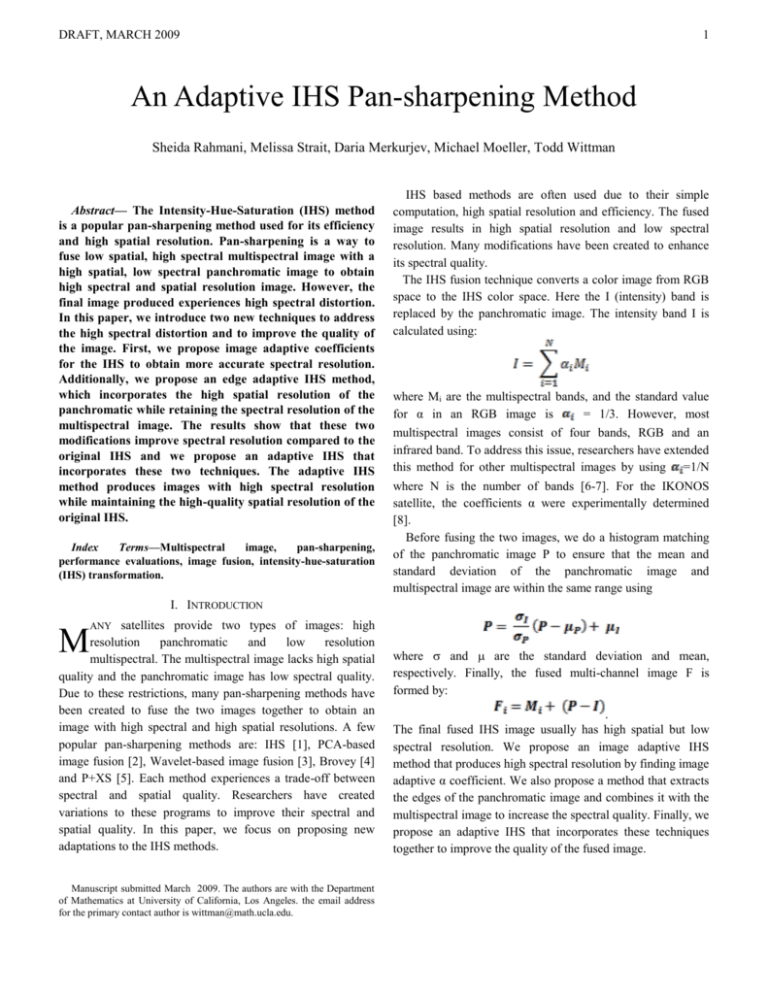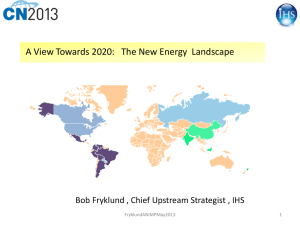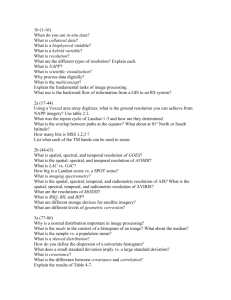C. Adaptive IHS - UCLA Department of Mathematics
advertisement

DRAFT, MARCH 2009 1 An Adaptive IHS Pan-sharpening Method Sheida Rahmani, Melissa Strait, Daria Merkurjev, Michael Moeller, Todd Wittman Abstract— The Intensity-Hue-Saturation (IHS) method is a popular pan-sharpening method used for its efficiency and high spatial resolution. Pan-sharpening is a way to fuse low spatial, high spectral multispectral image with a high spatial, low spectral panchromatic image to obtain high spectral and spatial resolution image. However, the final image produced experiences high spectral distortion. In this paper, we introduce two new techniques to address the high spectral distortion and to improve the quality of the image. First, we propose image adaptive coefficients for the IHS to obtain more accurate spectral resolution. Additionally, we propose an edge adaptive IHS method, which incorporates the high spatial resolution of the panchromatic while retaining the spectral resolution of the multispectral image. The results show that these two modifications improve spectral resolution compared to the original IHS and we propose an adaptive IHS that incorporates these two techniques. The adaptive IHS method produces images with high spectral resolution while maintaining the high-quality spatial resolution of the original IHS. Index Terms—Multispectral image, pan-sharpening, performance evaluations, image fusion, intensity-hue-saturation (IHS) transformation. IHS based methods are often used due to their simple computation, high spatial resolution and efficiency. The fused image results in high spatial resolution and low spectral resolution. Many modifications have been created to enhance its spectral quality. The IHS fusion technique converts a color image from RGB space to the IHS color space. Here the I (intensity) band is replaced by the panchromatic image. The intensity band I is calculated using: where Mi are the multispectral bands, and the standard value for α in an RGB image is = 1/3. However, most multispectral images consist of four bands, RGB and an infrared band. To address this issue, researchers have extended this method for other multispectral images by using =1/N where N is the number of bands [6-7]. For the IKONOS satellite, the coefficients α were experimentally determined [8]. Before fusing the two images, we do a histogram matching of the panchromatic image P to ensure that the mean and standard deviation of the panchromatic image and multispectral image are within the same range using I. INTRODUCTION satellites provide two types of images: high resolution panchromatic and low resolution multispectral. The multispectral image lacks high spatial quality and the panchromatic image has low spectral quality. Due to these restrictions, many pan-sharpening methods have been created to fuse the two images together to obtain an image with high spectral and high spatial resolutions. A few popular pan-sharpening methods are: IHS [1], PCA-based image fusion [2], Wavelet-based image fusion [3], Brovey [4] and P+XS [5]. Each method experiences a trade-off between spectral and spatial quality. Researchers have created variations to these programs to improve their spectral and spatial quality. In this paper, we focus on proposing new adaptations to the IHS methods. M ANY Manuscript submitted March 2009. The authors are with the Department of Mathematics at University of California, Los Angeles. the email address for the primary contact author is wittman@math.ucla.edu. where and are the standard deviation and mean, respectively. Finally, the fused multi-channel image F is formed by: . The final fused IHS image usually has high spatial but low spectral resolution. We propose an image adaptive IHS method that produces high spectral resolution by finding image adaptive α coefficient. We also propose a method that extracts the edges of the panchromatic image and combines it with the multispectral image to increase the spectral quality. Finally, we propose an adaptive IHS that incorporates these techniques together to improve the quality of the fused image. DRAFT, MARCH 2009 2 II. MODIFICATIONS TO IHS A. Image Adaptive Coefficients In order to minimize spectral distortion in the IHS pansharpened image, we propose a new modification of the IHS that varies the manner the intensity band is calculated depending on the initial multispectral and panchromatic images. To minimize spectral distortion the intensity band should approximate the panchromatic image as closely as possible. Therefore in this adaptive IHS method we want to determine the coefficients that best approximate the edges from the panchromatic image, and where there are edges we impose the IHS method and on the locations where there are no edges we simply put the multispectral image. The fused multi-channel image F is formed by the new formla: where h(x) is an edge detecting function. We want h(x) to equal 1 one on edges and equal to zero off edges. The extracted edge can be obtained using standard edge detection methods such as Canny and Sobel [9]. The method that produced the best result is the exponential edge detection method, which is both easy and efficient to use [10]. The edges of the panchromatic image are extracted using an exponential edge detector In order to calculate these coefficients we create the following function G to minimize with respect to the where The first term ensures that the coefficients yield a linear combination that approximates the panchromatic image. Physically we do not want negative , therefore we add the non-negativity constraint on the parameter indicating how large the gradient should be in order to be an edge, also it controls the smoothness of the image, and ε is a small value that enforces a nonzero denominator [11]. The values that proved successful are λ = using the Lagrange multiplier γ. Achieving negative α variables would not physically make sense. In order to solve this minimization problem we use a gradient descent method. Calculating the derivative with respect to gives us: We discretize the PDE we get from the gradient descent using a semi-implicit scheme. is the gradient of the panchromatic image, λ is a = and ε . Using these values and combining the edge detection with the original IHS increases the spectral resolution drastically compared to the original IHS. C. Adaptive IHS Due to the high performance of the edge adaptive method and image adaptive coefficient method, we also present a method that combines these two techniques. The integration of these two techniques with IHS we call adaptive IHS. This method preserves the high spatial quality and increases the spectral quality. In this method, the ’s are computed to create the I band, and the edge detection formula h(x) is inserted as well to compute the final fused image. We compare the performance of these three methods in the following section. Solving for gives: III. RESULTS This equation can be solved quickly by linear algebra methods. Calculating the coefficients in this manner increases the spectral quality of the images because it generates coefficients according to the original data, and maintains the good spatial quality of the IHS method. B. Edge Adaptive In this method, we want to transfer the edges from the panchromatic image to the fused image. This approach extracts Four band QuickBird data was used for our experiments. The original IHS, edge adaptive, image adaptive, and adaptive IHS methods are being compared for their spectral and spatial quality. Spatial quality can be judged visually, but spectral differences are more difficult to notice in this manner. Therefore, we consult the performance metrics in order to evaluate the results. We use several different metrics to help us analyze our results. Spectral Angle Mapper (SAM) calculates the average change in angle of all spectral vectors [12]. Spectral Information Divergence (SID) views each pixel spectrum as a DRAFT, MARCH 2009 3 random variable and then measures the discrepancy of probabilistic behaviors between spectra [13]. A Universal Image Quality Index (Q-average) models any distortion as a combination of three different factors: loss of correlation, luminance distortion, and contrast distortion [14]. The relative average spectral error (RASE) characterizes the average performance of the method of image fusion in the spectral bands [15]. We also used mean squared error (RMSE) and correlation coefficient (CC) to analyze and compare the spectral quality [16]. The CC calculates the spectral distortion by comparing the CC between the original multispectral bands and the bands of the final fused image. RMSE is the root mean square error between the fused image and the multispectral image. Relative dimensionless global error in synthesis (ERGAS) is a normalized version of RMSE designed to calculate the spectral distortion [17]. In Fig. 1. we can see the spectral differences in the images. The original IHS method is spectrally distorted whereas the combined adaptive method preserves the spectral quality of the original multispectral very closely. We can see this primarily in the color of the track. The color blue in the combined adaptive method is the same as the color of the track in the multispectral, but in the IHS it is a much darker blue. Similar behavior is present in Fig. 2. as well. The spectral (a) distortion is present in the original IHS method where the color of the swimming pool is much darker compared with the original multispectral image. Next we look at the metrics to evaluate the spectral quality. We want the metrics to correspond to our prediction of the methods. In Table. 1 and Table 2, which corresponds to Fig. 1 and Fig. 2, respectively, there is an increase in the metric results as we had expected. In both tables, the values of the metrics get closer to the optimal when using the Adaptive IHS. The image adaptive and edge adaptive both perform better than the original IHS. Combining the techniques achieves even better results. IV. CONCLUSION There are many Pan-sharpening methods. The IHS method gives good spatial quality. To improve its spectral quality we proposed the two new techniques: edge adaptive and image adaptive. The merging of these techniques improves the spectral quality of the IHS fused image while maintaining its spatial resolution. Therefore we proposed the adaptive IHS that incorporates both of these techniques, which in turn presents the best spectral quality amongst these methods. The performance evaluation metrics confirmed the competence of the adaptive IHS method. (b) (c) Fig. 1 (a) Original multispectral image. (b) IHS fused image. (c) Adaptive IHS fused result . Copyright DigitalGlobe, NextView license, 2003. (a) (b) Fig. 2. (a) Original multispectral image. (b) IHS fused image. (c) Adaptive IHS fused result. Copyrigh DigitalGlobe, NextView license, 2 (c) DRAFT, MARCH 2009 4 Table 1: Spectral quality metrics for Fig. 1. CC ERGAS Qave RASE RMSE SAM SID Reference Values 0 0 1 0 0 0 0 Original IHS 0.0435 2.9169 0.9940 11.3291 0.0316 0.8321 0.0021 Edge Adaptive IHS 0.0215 2.5625 0.9956 9.9630 0.0278 05617 0.0017 Image Adaptive IHS 0.0150 2.2144 0.9965 8.5663 0.0239 0.5921 0.0007 Adaptive IHS 0.0060 2.0220 0.9972 7.8243 0.0218 0.4288 0.0004 Table 2: Spectral quality metrics for Fig. 2. CC ERGAS Qave RASE RMSE SAM SID Reference Values 0 0 1 0 0 0 0 Original IHS 0.0497 3.1945 0.9913 12.6797 0.0528 1.1292 0.0128 Edge Adaptive IHS 0.0359 2.8586 0.9929 11.3882 0.0475 0.8857 0.0124 Image Adaptive IHS 0.0079 2.3379 0.9938 9.2548 0.0386 0.6740 0.0021 Adaptive IHS 0.0093 2.2368 0.9943 8.8486 0.0369 0.5826 0.0017 ACKNOWLEDGMENT The author would like to thank Professor A. Bertozzi for her advice and assistance. This work was supported by NSF grant (RTG - insert) and the Department of Defense. REFERENCES [1] T.Tu, S. Su, H. Shyn and P. Huang. “A new look at IHS like image fusion methods.” Information Fusion 2. pp. 177-186. 2001. [2] V. P. Shah, N. H. Younan. “An efficient Pan-Shapening Method via a Combined Adaptive PCA Approach and Contourlets.” IEEE Trans. on Geosc. and Remote Sens. 46. 2008. [3] X. Otazu, M. Gonzalez-Ausicana. “Introduction of Sensor Spectral Response Into Image Fusion Methods. Application to Wavelet-Based methods.” IEEE Transactions of Geoscience and Remote Sens. vol. 43, pp. 2376-2385, 2005. [4] A. Eshtehari, H. Ebadi. “Image Fusion of Landsat ETM+ and Spot Satellite Images Using IHS, Brovey and PCA.” Toosi University of Technology. 2008. [5] C. Ballester, V. Caselles, and L. Igual, and J. Verdera. “A Variational Model for P+XS Image Fusion.” International Journal of Computer Vision. pp.43-58. 2006. [6] Y. Zhang. “Understanding Image Fusion.” PCI Geomatics. 2008. [7] M. Choi. “A New Intensity-Hue-Saturation Fusion Approach to Image Fusion with a Tradeoff Parameter.” IEEE Transactions of Geoscience and Remote Sensing. 44. 16721682. 2006. [8] M. Choi and H. Kim, N.I. Cho, and H.O. Kim. “An Improved Intensity-Hue-Saturation Method for IKONOS Image Fusion.” International Journal of Remote Sensing. 2008. [9] J. Canny, “A computational approach to edge detection,” IEEE Trans. Pattern Anal. Mach. Intell.,vol. PAMI-8, no.6, pp.679698, Nov. 1986. [10] P. Perona and J. Malik, “Scale-space and edge detection using anisotropic diffusion,” IEEE Trans. Pattern Anal. Mach. Intell., vol. 12, no. 7, pp. 629-639, Jul. 1990. [11] H. Aanaes and J. Sveinsson, “Model-based satellite image fusion,” IEEE Trans. Geosci. Remote Sens. Vol. 46, no. 5, May. 2008. [12] A. Goetz, W. Boardman and R. Yunas “Discrimination Among Semi-Arid Landscape Endmembers Using the Spectral Angle Mapper(SAM) Algorithm.” Proc. Summeries 3rd Annu. JPL Airborne Geosci Workshop. 147-149. 1992. [13] C. Chang. “Spectral Information Divergence for Hyperspectral Image Analysis” Proc. Geosci. Remote Sens. Symp. 1. 509511. 1999. [14] A. Bovik and Z. Wang, “A Universal Image Quality Index.” IEEE Signal Processing Letters. 2002. [15] M .Choi, R. Kim. “Fusion of Multispectral and Panchromatic Satellite Images Using the Curvelet Transforms.” IEEE Geosci. Remote Sens. Lett. 2006. [16] Q. Du, O. Gungor, and J. Shan. “Performance Evaluation for Pan-sharpening Techniques.” Department of Electrical and computer engineering, Mississippi State University. 24. 2008. [17] L. Wald. “Quality of High Resolution Synthesized Images: Is There a Simple Criterion?” Proc. Int. Conf. Fusion Earth Data. 2000.







